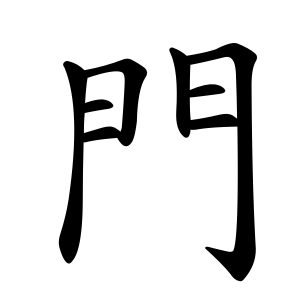門
- gate, door;
- gateway, portal;
It also carries meanings such as 'long-lasting', 'family or household', and 'method' or 'way'.
Etymology
It is a pictogram representing a gate with two doors.
Usage in Korean
When 門 (gate) is used as a radical, a new character is formed by placing another character between the two “doors.” For example:
間 (間: space, interval) — with 日 (sun) inside
閑 (한가할 한) — with 木 (tree) inside
開 (열 개: open) — with 幵 (open) inside
關 (관계할 관) — with 糸 (silk/thread) inside
閉 (닫을 폐) — with 才 (talent) inside
These characters share the 門 radical because the idea of a gate or door is central to their meaning.
So the pattern is: two “door” sides with another character placed in the middle to form a new meaning related to gates, spaces, or openings.
Additional notes
In Japan, this character specifically refers to a "large gate" or main gate, while common doors such as room doors are usually referred to by characters like 扉 (door flap) or 戶 (door/gate).
In simplified Chinese, most of these switch to 门 as the radical, which is the simplified form of 門. Some characters have been replaced entirely (e.g., 闇 → 暗) or have lost the 門 radical in simplification (e.g., 開 → 开, 關 → 关).
Characters with 門
Words that derived from 門
- 日弓 (AN)
- ⿰ 𠁣 𠃛
